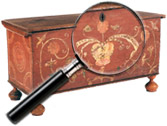|
|
Richard & Rosemarie Machmer Provenance
The following remembrances were publishing the Pook and Pook auction catalogue for this sale, held on October 24 and 25, 2008. For coverage of this sale, please see the account in Maine Antique Digest, published in January of 2009, available at http://www.maineantiquedigest.com/stories/index.html?id=1014.
About thirty-five years ago, I traveled around two hours to an evening country auction in Schnecksville, Pennsylvania. As I walked into the auction house, facing me was [...] Click here to continue reading.
Bijar
Bijar is frequently, and incorrectly, spelled Bidjar. The inserted “d” may originate from filtering the Persian name through Russian and French translations attempting to cope with pronounciation issues, but the correct spelling in both English and Persian is Bijar. The term denotes rugs from the town of Bijar in northwest Iran – in Walter Hawley’s marvelously redolent phrase, “one hundred miles beyond Hamadan, on the road to Tabriz”. The region’s population is largely [...] Click here to continue reading.
The Lantern Bearers
This 1908 painting by Maxfield Parrish was originally painted as the frontispiece for Collier’s 10 December 1910 issue, and is considered a prime example of Parrish’s work from this period. The original painting sold on 25 May 2006 at Christie’s New York for $4,272,000 (estimated $1.5/$2.5 million).
Ormolu
Ormolu, an 18th-century English term, is from the French phrase or moulu, with “or” indicating gold and “moulu” being a form of an old French verb moudre, which means “to grind up.” (This French term for this technique is bronze dore.) This idea of “ground-up gold”refers to the production process of ormolu, where high-quality gold is finely powdered and added to a mercury mixture and applied to a bronze object.
In reality, [...] Click here to continue reading.
The Grenfell Mission Mat, by Robert Meltzer
In 1892, Dr. Wilfred T. Grenfell, physician, missionary and ardent mariner, arrived on the coast of Labrador to investigate conditions among the fishermen there. He found no resident doctor anywhere along the 1,000 plus miles of coastline. Many of the fishermen, primarily of English descent, lived there year-round, “liveyeres” as they were called, in remote villages, without roads, far from shops and/or markets, in poorly constructed huts [...] Click here to continue reading.
White & Wood Pottery
The White & Wood Pottery was opened in Binghamton, New York by Charles N. White and George L. Wood in 1883. They made stoneware there until 1887, using the mark “White & Wood/Binghamton, N.Y.” (the first line in an arc).
Charles White was the son of Nicholas A. White of White’s Potttery in Utica, New York. In 1882 Charles White was made a partner of that pottery and its mark [...] Click here to continue reading.
Consolidated Lamp & Glass Company
The Consolidated Lamp and Glass Company was formed in Fostoria, Ohio in 1893 from the merger of the Fostoria Shade and Lamp Company with Wallace and McAffee Company. They moved to Coraopolis, Pennsylvania when their glassworks burned down in 1895. In the 1890′s they produced some art glass vases and bowls, but for many years their main production was high quality lamps, globes and shades. Beginning in 1925 its [...] Click here to continue reading.
Filigree or Quillwork
Rolled paper-work, originally known as filigree (and, occasionally, quillwork in America), became a schoolgirl pursuit in England following the restoration of Charles II in 1660. It remained a popular activity well into the 18th century.
Despite the colonial taste for English fashions, the only American colonial filigree know today was made in Boston between the 1690′s and the 1750′s. English girls made filigree coats-of-arms and the earliest Boston example is 1693. [...] Click here to continue reading.
Marcus Illions-Carousel Carver
Marcus Illions was a Russian immigrant who became famous as Coney Island’s master carousel artist. His horses are known for their flamboyant, highly animated poses, and unique gold-leaf manes.
Shaker Chairs
The Shakers produced five chair types: the rolled arm, scrolled arm, back with cross rail, front upright with mushroom turned upper ends and the armless sewing rocker. Chair backs are slat back in form. Seats made of rush, splint woven, woven tape or caned. Upholstery was not used, except in very late examples. Shaker chairs were made of a variety of woods, with maple being the most commonly found. Sometimes with multiple [...] Click here to continue reading.
|
Recent Articles
- Charles Alfred Meurer – American Artist & Tromp L’Oeil Artist
- Sendak, Maurice – American Artist & Writer
- Godie, Lee – American Artist
- Davis, Vestie – American Artist
- Bartlett, Morton – American Artist
- Mackintosh, Dwight – American Artist
- Evans, Minnie Jones – African-American Artist
- Mumma, Ed (Mr. Eddy) – American Artist
- Nice, Don – American Artist
- Savitsky, John (Jack) – American Artist
- Gordon, Harold Theodore (Ted) – American Artist
- Dial, Thornton – African-American Artist
- Doyle Sam – American Artist
- Johnson, Lester Frederick – American Artist
- Finster, Howard – American Artist
|
|
